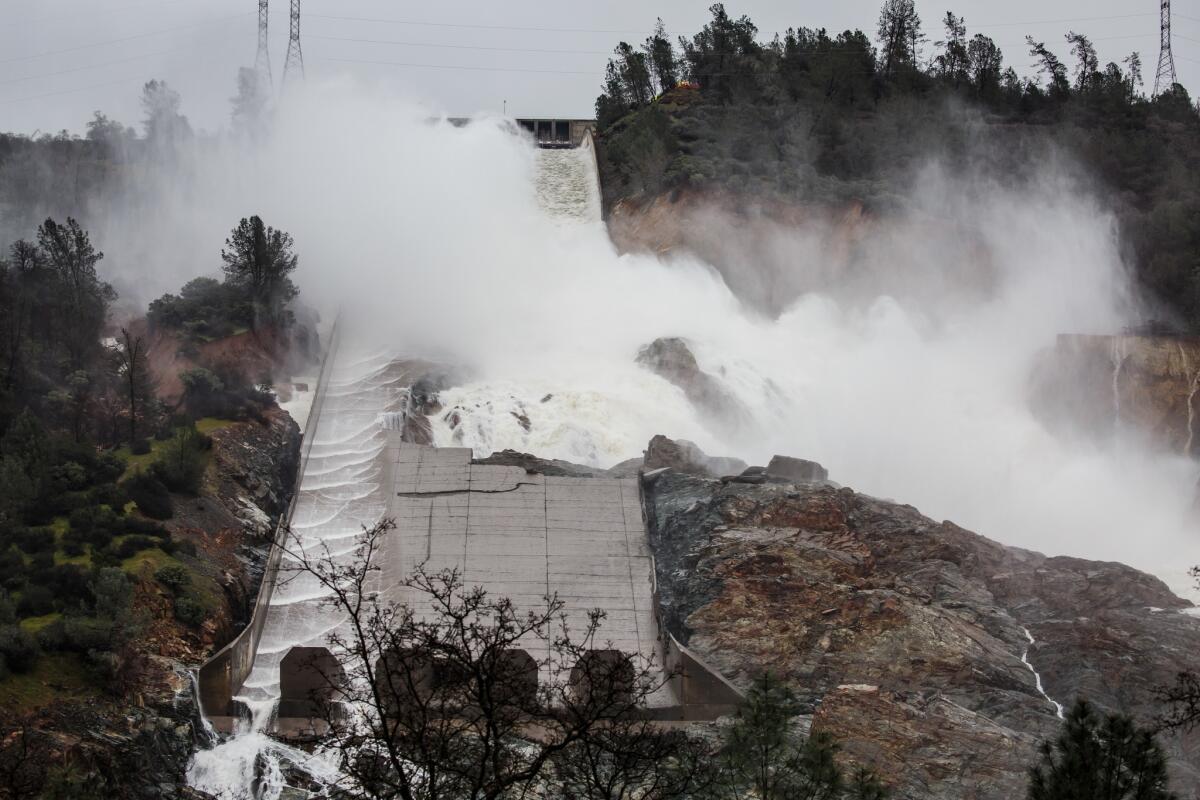Costs soar and cracks revealed in Oroville Dam spillway, but officials say it’s ready for winter rains
- Share via
In the coming months, the Oroville Dam will face its first big test since a crisis earlier this year forced the evacuation of hundreds of thousands of residents below its mangled spillway.
Officials have been planning for the coming of the winter rains at the nation’s tallest dam and are confident it can handle heavy rain and snow runoff from the Sierra without interrupting the extensive reconstruction of its main spillway, which was damaged.
Costs have climbed and cracks have appeared on the surface along the spillway, but officials this week downplayed those issues.
Project leaders and Department of Water Resources officials said that hairline cracks that have been found on a portion of the newly built concrete spillway are “not a concern” and that the patched-up structure can handle winter rains if necessary.
Officials say they don’t think they will need to use the spillway to move water from the reservoir down into the Feather River. The state has been relying on a hydroelectric plant at the foot of the dam that can drain up to 14,000 cubic feet per second of water since the spillway gates were closed in May.
If everything goes according to plan — and the weather cooperates — the spillway won’t have to be used at all this winter.
The 49-year-old reservoir has used its spillway in only 26 of those years, with its heaviest use coming during the 2016-17 winter, the wettest on record in Northern California.
The reservoir, finished in 1969, would need to take about an additional 2 million acre-feet of water in to require the flood control spillway’s use this winter, said DWR spokeswoman Erin Mellon. Oroville Reservoir’s capacity is about 3.5 million acre-feet.
The spillway structure was badly damaged in February among record rains and needs to be rebuilt. When it failed, the reservoir exceeded capacity and an adjacent emergency spillway (at the time, nothing more than an earthen hill) was used. But that too rapidly eroded and nearly failed, triggering a massive evacuation in Butte County downriver.
In April, the state awarded a $275-million contract to Kiewit to fix both spillways and a splash pool at the bottom when the project’s final design was only 30% completed, Mellon said. That contract since has increased to $500 million.
To rebuild the structure, Kiewit is using a sturdier cement than what was available 50 years ago, said the company’s project manager, Jeff Peterson.

The cement mixture contains fly ash, a remnant of burned coal with a tiny, glassy bead-like structure that has a lubricating effect and allows the cement to reach crevices it may otherwise miss, and silica fume, which increases the cement’s density and cohesion.
The resulting cement, when cured, can shrink and leave minute cracks half the thickness of a human nail when it’s tightly anchored in place, Peterson said. Hundreds of those cracks were found by federal inspectors on parts of the new spillway in August, and DWR said it is monitoring them going forward.
“We’ve verified that everything is per the design on this job, and that’s why we’re confident that the structural integrity is good,” Peterson said.
Amy Rechenmacher, an associate professor of civil and environmental engineering at USC, concurred with Peterson’s assurances.
Unless the cracks are deep and are vertically offset — meaning you’d feel a difference in leveling if you rolled something over them — then they should be considered a non-issue.
“There’s no concrete slab in the world that doesn’t have a few cracks in it,” she said.
About 40% of the final concrete on the spillway has been placed. The entire top section of the spillway will be destroyed and rebuilt next year.
A preliminary analysis of the cause behind the spillway’s failure in February pointed to a series of questionable decisions during construction, including relying on relatively thin layers of concrete around vital spillway joints, poor drainage for water that seeped into the chute and weak reinforcements.
The new main spillway will be thicker with better drainage and stronger joints. The adjacent emergency spillway is being armored with cement that’s rooted deeper in the bedrock.
The final design gives the main spillway the ability to drain as much as 270,000 cubic feet of water per second, but it will have less than half that capacity (about 100,000 cfs) through this winter, officials said.
To avoid catastrophe, the state has kept the reservoir’s level lower than usual going into winter.
For breaking California news, follow @JosephSerna on Twitter.
More to Read
Sign up for Essential California
The most important California stories and recommendations in your inbox every morning.
You may occasionally receive promotional content from the Los Angeles Times.













